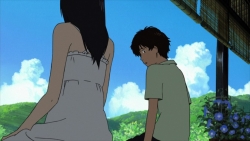 By Brian Lafferty
By Brian Lafferty
January 23, 2011 (San Diego) -- Every few years we get a Japanese anime, mainly from Hayao Miyazaki (Ponyo, Spirited Away). This year’s import is not from Miyazaki but from Mamoru Hosoda. Summer Wars features one of the most unlikely genre combinations: shomin-geki (a genre that depicts the lives of ordinary, working-class families) and technothriller.
Summer Wars (dubbed in English) opens with an advertisement for OZ, a virtual world where many people from around the globe interact with each other. Our hero, Kenji is one of the engineers of this online community and is in love with Natsuki. She brings him to meet her family, to whom she passes him off as her fiancé. When Kenji unwittingly helps a malicious form of artificial intelligence crack OZ’s encryption, it has dire consequences, including the possible annihilation of all life on Earth.
The animation is split into both hand-drawn and computer generated. The scenes in the real world are hand-drawn. Hosoda brings a simple design to the house, the rooms, and the yard. The colors and textures are not exactly eye-popping but they communicate the simple, safe world these characters inhabit when not at the computer.
This is in marked contrast to OZ, which is clearly, and appropriately, computer generated. Unlike the rougher edges and softer colors and textures of the village, OZ is designed with very sleek textures and saturated colors. These segments have a definite “virtual” feel.
One director notable for his work in the shomin-geki genre is Yasujiro Ozu (Tokyo Story). Hosoda and writer Satoku Okudera include many subtle references to this prolific director. The logo for OZ includes a symbol next to it that looks like a filled-in “u.” Ozu was known for keeping the camera positioned no higher than three-feet above the ground. Some shots follow this style, especially when characters sit at the table or are at the computer. This brings a lot of intimacy when Kenji and Natsuki’s cousin tries to fight the AI, especially when Natsuki’s family crowds over the screen.
The film’s shomin-geki traits are as powerful as the virtual war between Kenji and the AI. For starters, how would you react when the girl of your dreams passes you off to her family as her fiancé? Kenji already doesn’t know how to act around or even talk to Natsuki because he’s so taken by her beauty. Now not only does he have to keep up the lie but he also has to deal with the shame of triggering OZ’s destruction.
The very intense technothriller elements act as an unsettling commentary on our reliance on technology. The destruction of Japan’s infrastructure, from car accidents caused by malfunctioning stoplights, to flooding, to the threat of nuclear weapons detonating, is frightening. It could happen and this theory is communicated without sounding very on-the-nose.
Buried subtly beneath all the family squabbles and the destruction, both in the real world and the virtual world, is an important theme: shame. From the family bias against Natsuki’s outsider uncle Wabisuke (fathered illegitimately by her great-grandfather) to the fallout over Kenji’s triggering of the online and real-world destruction, this theme is earnestly expressed. As a result, I felt myself treated to two battles: the online battle to save mankind and Kenji and Wabisuke’s respective quests for redemption.
Summer Wars is playing until Thursday at the Ken Cinema.
You can reach Brian Lafferty at brian@eastcountymagazine.org. You can follow him on Twitter: @BrianLaff.











Recent comments